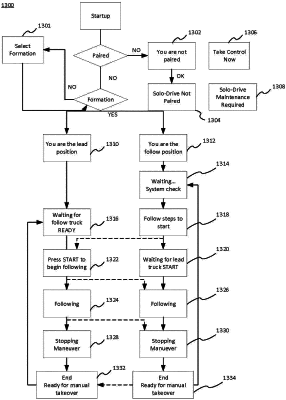| CPC G05D 1/0293 (2013.01) [B60W 10/04 (2013.01); B60W 10/18 (2013.01); B60W 10/20 (2013.01); B60W 30/18 (2013.01); G05D 1/0088 (2013.01); B60W 2420/42 (2013.01); B60W 2420/52 (2013.01); B60W 2556/60 (2020.02); B60W 2556/65 (2020.02); B60W 2710/0666 (2013.01); B60W 2710/18 (2013.01); B60W 2710/20 (2013.01); B60W 2720/106 (2013.01); B60W 2756/10 (2020.02); G05D 2201/0213 (2013.01)] | 10 Claims |

|
1. A method for causing a rear vehicle to follow a front vehicle, comprising:
in response to a driver of the front vehicle activating an FTL (Follow-the-Leader) session;
establishing a wireless communication link between a front vehicle and a rear vehicle, wherein the wireless communication link transmits front vehicle information including information about its steering angle, engine torque, and braking system; and
beginning the FTL session, wherein the FTL session comprises:
transmitting, from the first vehicle to the rear vehicle, the information about the front vehicle's steering angle, engine torque, and braking system; and
commanding engine torque, a braking system, and steering at the rear vehicle without input from a driver, wherein the commanding of the engine torque, the braking system, and the steering is based on the information about the front vehicle's steering angle, engine torque, and braking system, and wherein the commanding of the engine torque, the braking system, and the steering eliminates the need for driver input.
|